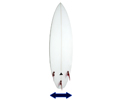Materials
Know Your Foam
The other day I walked into a surf shop and saw a board that looked just like a traditional Polyurethane fiberglass surfboard. It was the usual off white color, with a center balsa stringer coated in fiberglass resin. The sales guy says "that board is a sweet epoxy board." I scratched my head because when I hear epoxy, I think of Surftech's Tuflite boards. You know the boards that look like they’re coated in a hard plastic shell with no stringer. So I decided to do some investigating.
Polyurethane
 The main choice of surfboard foam these days are Polyurethane (PU), Polystyrene (PS) or Expanded Polystyrene (EPS) foam. Polyurethane foam has been the shaper's choice since the 1950s. One of the advantages is that it is light and very shapeable. If you look at it up close, it's very fine and brittle so you can take sand paper and shave off corners without tearing into it. If you plan on buying a custom surfboard, most likely it’s made from Polyurethane. However, one of the biggest downsides is its highly toxic nature. It has potential hazards to individuals working with these materials, possible contamination to the environment and they're a non-renewable product. There was an influx of new surfboard construction and use of different composites when Clark Foam, the biggest distributor of Polyurethane foam blanks, closed their doors in 2005.
The main choice of surfboard foam these days are Polyurethane (PU), Polystyrene (PS) or Expanded Polystyrene (EPS) foam. Polyurethane foam has been the shaper's choice since the 1950s. One of the advantages is that it is light and very shapeable. If you look at it up close, it's very fine and brittle so you can take sand paper and shave off corners without tearing into it. If you plan on buying a custom surfboard, most likely it’s made from Polyurethane. However, one of the biggest downsides is its highly toxic nature. It has potential hazards to individuals working with these materials, possible contamination to the environment and they're a non-renewable product. There was an influx of new surfboard construction and use of different composites when Clark Foam, the biggest distributor of Polyurethane foam blanks, closed their doors in 2005.
Polystyrene
Polystyrene (PS) foam is a lighter alternative to traditional Polyurethane foam. However, it takes about two to four times the labor to shape. They're not as strong as Polyurethane but with the coating of epoxy resin, it becomes durable enough. Polyester resin (used to make fiberglass) dissolves polystyrene foam so the addition of epoxy resin is needed to prevent this. It also has the advantages of being environmentally friendly and recyclable. Like Polyurethane, you can also buy blocks of polystyrene foam and shape your own board.
Expanded Polystyrene
Expanded Polystyrene (EPS) foam is a version of polystyrene foam. They are now gaining popularity and they’re typically found in the core of Surftech's Tuflite and Firewire surfboards. You probably already familiar with EPS foam. The light disposable coolers you can buy at the super market are EPS foam. They’re also the same foam used to safeguard products in boxes or packages. They’re made up of tiny little foam balls similar to the size of BB's and compress together with an adhesive. EPS is typically the lightest of the three foams used in surfboards. The disadvantage of using EPS foam is the difficulty of hand shaping it. If you took a sand paper to that disposable cooler, you'll know what I mean. You'll end up tearing chucks of foam out with the sand paper. If you're looking for a custom board, it will be very difficult to find a shaper who would want to work with this material. Surfboards made from EPS foam are typically molded by machines. It is possible to buy molded shaped EPS foam. This is where the term "Pop out" board comes from. Also, EPS foam is more prone to absorb water but recent developments have been able to improve those issues.
Density vs. Buoyancy
When choosing a surfboard, one important aspect of performance not to overlook is its weight. A lighter board means more buoyant and floatable. When you compare three boards, made from the three different types of foam, the lowest density or lightest board will float you the best. The advantageous of better buoyancy is great for paddling and allowing you to ride a smaller board for maneuverability. Each type of foam can have different density levels depending on how much the material has been compressed. Typically EPS is the lightest of the three and Polystyrene is lighter than Polyurethane foam. However you might also want to weigh your decision on the durability of the surfboard as well. Polyurethane surfboards are the easiest to repair. EPS foam core is less likely to deteriorate over time and companies like Surftech with their epoxy fiberglass shell tout that their boards will last longer than traditional Polyurethane fiberglass surfboards.















3 Comments